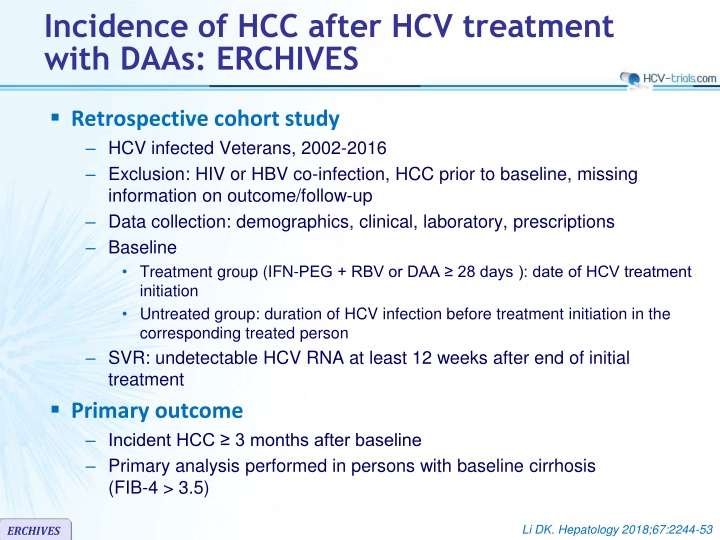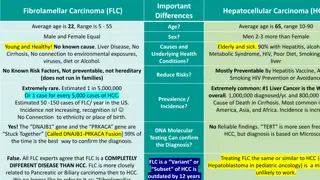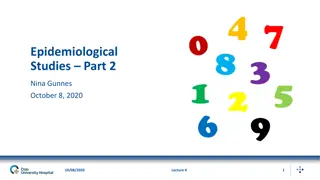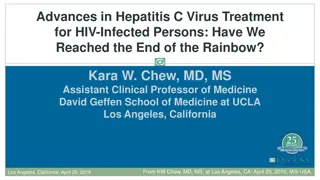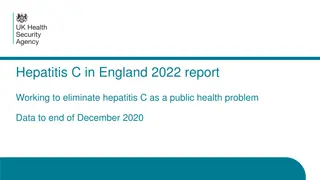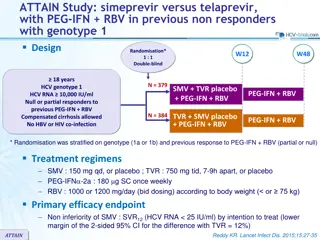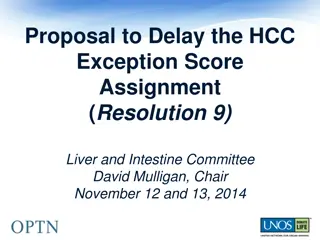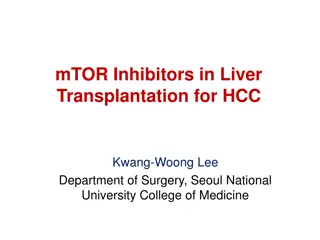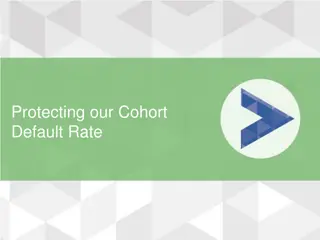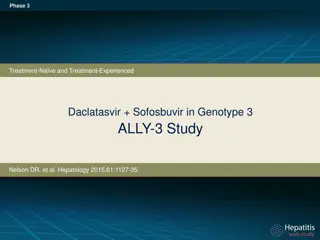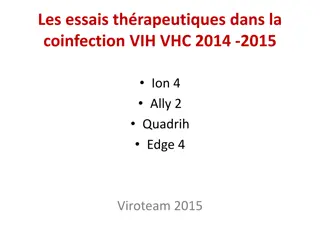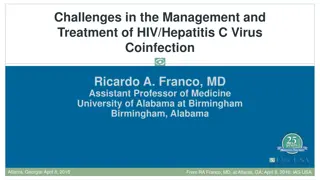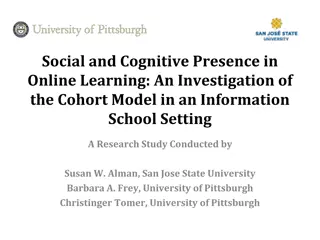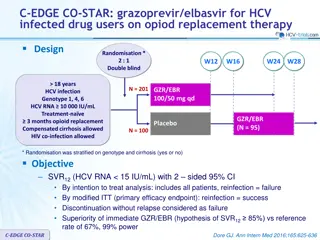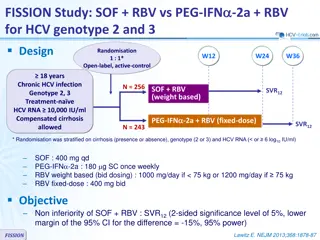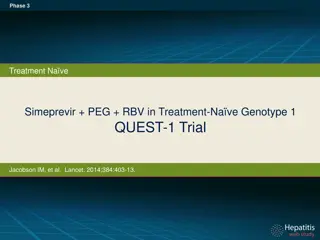Incidence of HCC after HCV Treatment with DAAs: ERCHIVES Retrospective Cohort Study
This study examines the occurrence of hepatocellular carcinoma (HCC) after hepatitis C virus (HCV) treatment with direct-acting antivirals (DAAs) among HCV-infected Veterans, excluding HIV or HBV co-infection. Data includes demographics, clinical details, treatment groups, and outcomes regarding incident HCC. The analysis focuses on individuals with baseline cirrhosis, providing insights into HCC development post-treatment.
Download Presentation

Please find below an Image/Link to download the presentation.
The content on the website is provided AS IS for your information and personal use only. It may not be sold, licensed, or shared on other websites without obtaining consent from the author.If you encounter any issues during the download, it is possible that the publisher has removed the file from their server.
You are allowed to download the files provided on this website for personal or commercial use, subject to the condition that they are used lawfully. All files are the property of their respective owners.
The content on the website is provided AS IS for your information and personal use only. It may not be sold, licensed, or shared on other websites without obtaining consent from the author.
E N D
Presentation Transcript
Incidence of HCC after HCV treatment with DAAs: ERCHIVES Retrospective cohort study HCV infected Veterans, 2002-2016 Exclusion: HIV or HBV co-infection, HCC prior to baseline, missing information on outcome/follow-up Data collection: demographics, clinical, laboratory, prescriptions Baseline Treatment group (IFN-PEG + RBV or DAA 28 days ): date of HCV treatment initiation Untreated group: duration of HCV infection before treatment initiation in the corresponding treated person SVR: undetectable HCV RNA at least 12 weeks after end of initial treatment Primary outcome Incident HCC 3 months after baseline Primary analysis performed in persons with baseline cirrhosis (FIB-4 > 3.5) Li DK. Hepatology 2018;67:2244-53 ERCHIVES
Incidence of HCC after HCV treatment with DAAs: ERCHIVES Baseline cohort characteristics IFN group (N = 3534) 54 95.9 67 / 17 18 25 84 29 / 16 / 9 6.11 38 46 / 13 3.2 100 15 / 19 / 66 66.6 196 (5.55) DAA group (N = 5834) 62 96.6 51 / 31 31 21 82 85 / 0.2 / 3.3 6.27 37 37 / 20 4.3 37 22 / 74 / 4 96.2 50 (0.86) Untreated group (N = 8468) 58 97.2 50 / 35 29 33 86 51 / 9 / 4.5 6.20 54 49 / 15 4.01 0 - Age, median years Male, % Race: white / black, % Diabetes, % Alcohol abuse history, % Smoking history, % HCV genotype: 1 / 2 / 3, % Baseline median HCV, log10IU/mL PPI use during treatment, % FIB-4 at baseline: no fibrosis, cirrhosis, % Median AFP, IU/mL Ribavirin use, % Treatment duration: 8W, 12W, 24W Attainment of SVR, % Incident cases of HCC, N (%) 436 (5.04) Li DK. Hepatology 2018;67:2244-53 ERCHIVES
Incidence of HCC after HCV treatment with DAAs: ERCHIVES Incidence rate of HCC in persons with cirrhosis Incidence Rate, per 1000 patient-Years p value (control: IFN) Treatment Group 95% CI All persons with cirrhosis IFN-RBV DAA regimens, overall SOF/SMV SOF/LDV Untreated controls 34.70 25.16 34.84 19.55 45.31 28.50 - 42.25 17.98 - 35.21 20.23 - 60.00 11.79 - 32.43 39.42 - 52.08 - 0.11 0.99 0.04 0.03 SVR12subgroup IFN-RBV DAA regimens, overall SOF/SMV SOF/LDV 21.20 22.80 33.26 15.49 14.91 - 30.14 15.84 - 32.81 18.89 - 58.56 8.58 - 27.97 - 0.78 0.18 0.37 Non-SVR12subgroup IFN-RBV DAA regimens, overall SOF/SMV SOF/LDV 48.90 62.81 81.24 69.87 38.56 - 62.02 26.14 - 150.9 11.44 - 576.7 26.22 - 186.2 - 0.59 0.61 0.49 Li DK. Hepatology 2018;67:2244-53 ERCHIVES
Incidence of HCC after HCV treatment with DAAs: ERCHIVES Cumulative probability of HCC development in persons with cirrhosis 0.15 SVR IFN-RBV SVR DAA No treatment 0.10 Logrank, p = 0.0004 0,05 0,00 0 6 12 18 24 Mois 280 857 1226 SVR IFN-RBV SVR DAA No treatment 285 1630 1423 283 1590 1328 270 297 1080 239 63 933 Li DK. Hepatology 2018;67:2244-53 ERCHIVES
Incidence of HCC after HCV treatment with DAAs: ERCHIVES Predictors for the development of HCC in persons with cirrhosis, HR (95% CI) 1.76 (1.26 2.46) Age, per 10-year increase Male sex Race (ref : white) Black Hispanic Other/missing Diabetes BMI, per 1-unit increase Alcohol abuse history Smoking history (ref : no smoker) Current smoker Former smoker Missing HCV genotype (ref : genotype 1) 2 3 4, 5, 6 Missing HCV RNA, per 1 log10increase PPI use (baseline onward) Statin use (baseline onward) AFP > 20 (vs < 20) Treatment regimen (ref : PEG-RBV) Any DAA Attainment of SVR 1.34 (0.32 5.62) 0.65 (0.37 1.13) 0.94 (0.45 1.95) 1.27 (0.77 2.10) 1.01 (0.67 1.50) 0.98 (0.95 1.01) 1.27 (0.85 1.89) 1.44 (0.79 2.60) 1.76 (0.96 3.23) 1.65 (0.82 3.33) 0.39 (0.16 0.95) 0.90 (0.47 1.72) No events (N/A) 0.81 (0.53 1.24) 0.96 (0.83 1.11) 1.65 (1.07 2.55) 0.50 (0.31 0.80) 4.10 (2.75 6.10) 1.07 (0.55 2.08) 0.66 (0.42 1.03) 0.1 1 5 10 Li DK. Hepatology 2018;67:2244-53 ERCHIVES
Incidence of HCC after HCV treatment with DAAs: ERCHIVES Conclusion DAA treatment is not associated with a higher risk of HCC in persons with cirrhosis with chronic HCV infection in the short term Previously reported higher rates of HCC associated with DAA treatment may be explained by both the presence of relatively fewer baseline HCC risk factors in persons treated with IFN-RBV as well as selection bias, given that DAA regimens were used to treat persons at higher risk for developing HCC Li DK. Hepatology 2018;67:2244-53 ERCHIVES
